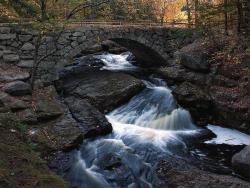
"Some of New Hampshire's most aesthetically pleasing yet least appreciated structures are stone arch bridges."
From: Stone Arch Bridges of the Contoocook River Valley, New Hampshire Profiles, May, 1978 by Raymond Gibson
These five bridges, Carr Bridge (mid 1800's), Gleason Falls Bridges (circa 1830), Gleason Falls Road over Beard's Brook (mid 1800's), Second New Hampshire Turnpike Bridge (circa 1864), and Sawyer Bridge (circa 1866), constitute the largest extant cluster of dry-laid stone arch bridges within the United States. They were built by trained masonry craftsmen and continue to demonstrate the durability of such construction.
Stone arch bridges were a solution to the weakness of timber bridges assaulted by spring floods and turbulent streams. The availability of stone from the many granite quarries and engineers experienced in building other stone structures such as dams, canals, and mill tailraces combined to make these stone arch bridges possible. Since the lime mortar available at this time was not suitable for this type of construction, the stones used for these bridges had to be carefully cut and fitted in order to create structures without the need for mortar. Having been built by different builders over a period of probably 30 to 40 years, they illustrate five different elements of dry-laid stone arch bridges: 1) spandrel walls of cut stone, 2) spandrel walls of field stone, 3) granite posts for rails (including keystones doubling as posts), 4) single arch and double arch structures, and 5) various span to rise proportions.
Because these dry-laid stone arch bridges were more rugged than timber bridges and withstood the frequent flooding of local streams, they enabled the development of a reliable transportation network throughout New England both locally and along the intercity turnpike system.


